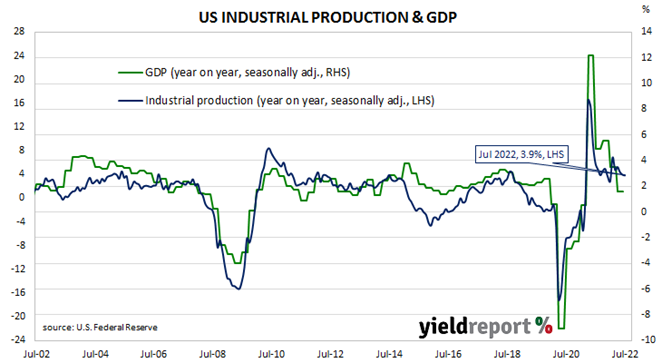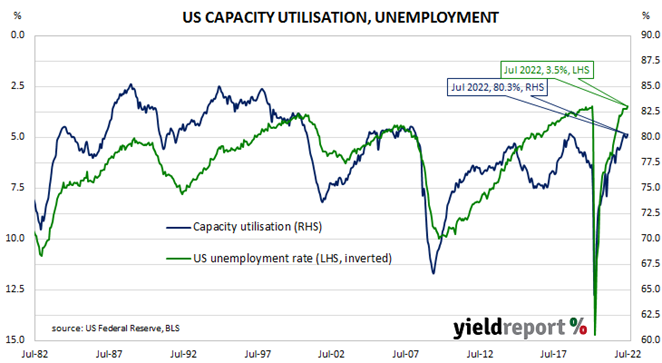Summary: US industrial output up 0.6% in July, double market expectations; up 3.9% over past 12 months; vehicle production “surges” as bottlenecks ease; capacity utilisation rate up 0.4ppts to 80.3%, just above long-term average.
The Federal Reserve’s industrial production (IP) index measures real output from manufacturing, mining, electricity and gas company facilities located in the United States. These sectors are thought to be sensitive to consumer demand and so some leading indicators of GDP use industrial production figures as a component.
US production collapsed through March and April of 2020 before recovering the ground lost over the fifteen months to July 2021.
According to the Federal Reserve, US industrial production expanded by 0.6% on a seasonally adjusted basis in July. The result was double the 0.3% increase which had been generally expected and a marked improvement on June’s flat result after it was revised up from -0.2%. However, on an annual basis the growth rate slowed from June’s revised figure of 4.0% to 3.9%.
NAB currency strategist Rodrigo Catril noted the increase was “driven by a 6.6% surge in motor vehicle production, on easing bottlenecks that are allowing a return to more normal production levels.”
Short-term US Treasury bond yields moved considerably higher on the day while longer-term yields barely changed. By the close of business, the 2-year Treasury yield had gained 9bps to 3.26%, the 10-year yield had added 2bps to 2.81 while the 30-year yield finished 1bp lower at 3.09%.
In terms of US Fed policy, expectations of a steeper path for the federal funds rate over the next 12 months firmed slightly. At the close of business, September contracts implied an effective federal funds rate of 2.525%, 20bps higher than the current spot rate. November contracts implied 3.295% while September 2023 futures contracts implied an effective federal funds rate of 3.46%, about 113bps above the spot rate.
The same report includes US capacity utilisation figures which are generally accepted as an indicator of future investment expenditure and/or inflationary pressures. Capacity usage had hit a high for the last business cycle in early 2019 before it began a downtrend which ended with April 2020’s multi-decade low of 64.2%. July’s reading increased from June’s revised figure of 79.9% to 80.3%, just above of the long-term average of 80.1%.
While the US utilisation rate’s correlation with the US jobless rate is solid, it is not as high as the comparable correlation in Australia.



